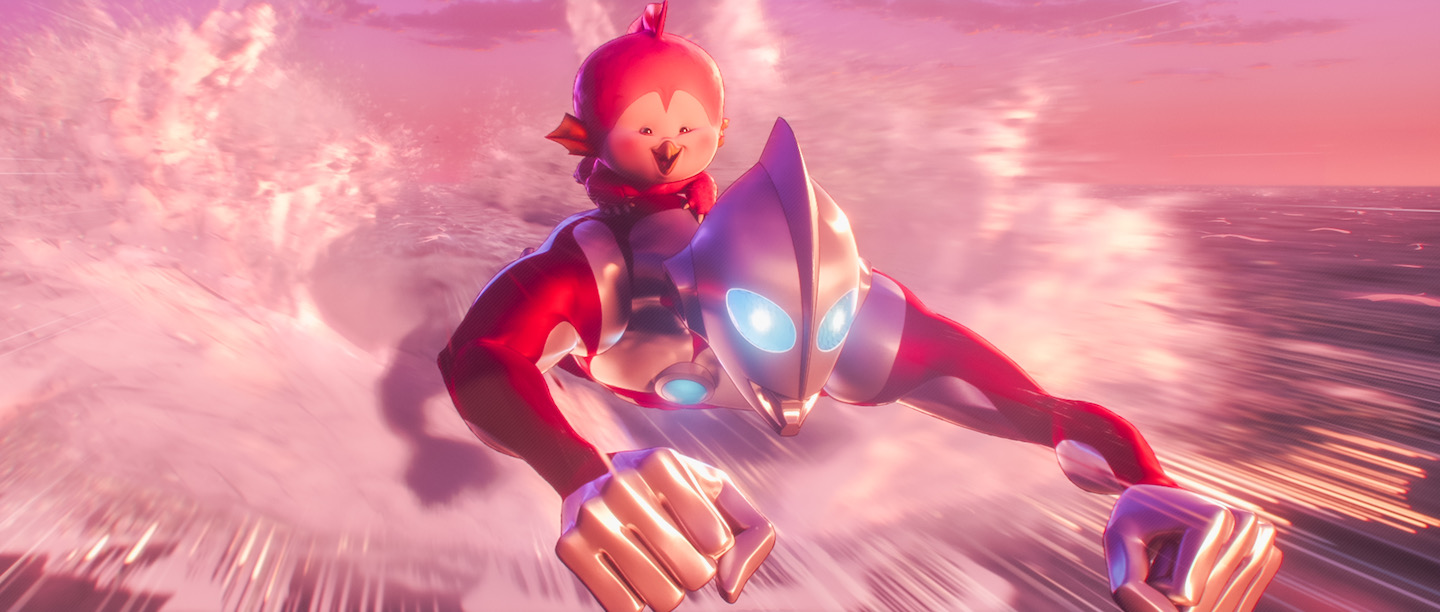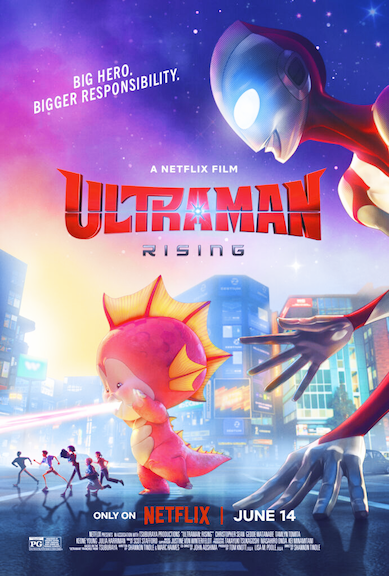
The narrative of “Ultraman: Rising” emphasizes family relationships, father-son dynamics and the parent-child emotional bond. (Image: Courtesy of Netflix)
Netflix’s new animated film helps JA actors rise up.
By Gil Asakawa, P.C. Contributor
The “Ultraman: Rising” film that Netflix debuted in June is the 44th official project featuring the giant Japanese superhero that has been battling kaiju, or giant monsters, since the original Ultraman TV series debuted in 1966. He’s been portrayed in live-action series and movies as an actor in a stiff rubber suit and drawn in anime and realistically using computer graphics.
“Ultraman: Rising” uses a contemporary cornucopia of digital effects that serves up a visual feast for the eyes and imagination, which breaks rules of anatomy and animation, while keeping viewers engaged with its cinematic sweep.
Ultraman’s figure is stretched crazily out of perspective, while some characters are depicted in a more traditional manga/anime style. But the action scenes are crazily kinetic with camera angles and zooms that feel photographic, not hand- (or computer-) drawn. After a while, viewers will forget they’re watching an animated feature.
The film also brings a different dynamic to the narrative, with its emphasis on family relationships, father-son dynamics and even the parent-child emotional bond. The story arc is family friendly.
“Ultraman: Rising” is also a Japanese American co-production that brings together powerhouse creative spirits across the Pacific, with Netflix Animation here and Tsuburaya Productions, the company that owns the entire franchise in Japan, and amazing animation by George Lucas’ Industrial Light & Magic.
Also, “Ultraman: Rising” is a first in the long list of shows, movies and manga properties that have been adapted for Western audiences to feature a Japanese American cast voicing the main characters.

“Ultraman: Rising” uses the voice talents of JA actors (from left) Christopher Sean, Tamlyn Tomita, Gedde Watanabe, Julia Harriman and Keone Young.
They include Christopher Sean as Ultraman and his alter-ego Ken Sato, the brash, Japan-born but American-raised baseball superstar who pulls a reverse Shohei Ohtani, who quits the L.A. Dodgers to return to Japan and play for the Yomiuri Giants and turn into Ultraman when a kaiju attacks.
Gedde Watanabe is the voice of Dr. Sato, Ken’s dad and elder Ultraman, who needs his son to take over the family business of protecting Japan from kaijus. Tamlyn Tomita plays the parts of Emiko Sato, Ken’s mom and also Mina, the ball-shaped AI robot that floats around and helps Ken. Keone Young voices Dr. Onda, the head of the Anti-Kaiju Defense Force, who seeks to destroy all kaiju. And Julia Harriman has the role of Ami Wakita, a newspaper reporter who befriends Ken Sato when he’s at his most egotistical, being the ugly American when he arrives in Tokyo.
In a recent group interview, these five actors shared their experiences working on “Ultraman: Rising.” Of the group, the senior members (and the ones with the longest list of credits) are Young, Watanabe and Tomita. Sean requested the opportunity to read their lines together in the studio because he’d done voice work for “Star Wars Resistance,” and he wanted that real-life camaraderie. Young wasn’t in the studio, but Sean said, “It’s a totally different chemistry when you’re working with the other actors. So, they were kind enough to allow us to work together. And I got to experience the Tamlyn Tomita, and Julia and Gedde, and they were just an incredible journey. It was a remarkable gift to be able to work with these titans of the industry and legends.”
Watanabe, who is best-known in the 1980s for his role as “Long Duk Dong” in “16 Candles” and has had a long successful résumé since, agrees that he cherished the in-studio interaction. “Chris, thank God that happened, to be honest,” he recalled. “[It was great] while we were working in the film to have human contact involved.”

“Ultraman: Rising” has been adapted for Western audiences. (Image: Courtesy of Netflix)
Harriman, the youngest cast member who’s a talented singer-songwriter who made her mark on stage in “Hamilton,” agreed that the experience was incredible, including working with Harriman, the second youngest.
“I just feel so lucky to have gotten to do it with these people,” she said. “And like Christopher was saying, we got to act together in the same room, and I learned so much from him — it was so great.” Harriman’s character builds a bond with Ken Sato without realizing he’s also Ultraman, and she’s a tantalizing story line that could be followed if Netflix greenlights a sequel …
Tomita is familiar to many viewers for her dozens of roles in films and TV, but she has only done voices on a handful of projects (last year she read the part of Lady Itoh in Netflix’s animated “Blue Eye Samurai”).
Voice work requires a different approach from traditional acting, she noted. “The only person that you have to work with in the room is the director, who is the writer as well. And it takes a whole lot more imagination.”
She also appreciates the film for its family focus. “You have to imagine the love of your life leads the double life as Ultraman and understand what it means to have a son who’s aspiring to become like his dad, like a lot of children do. They want to become just like their parents.”
The cast members also discussed the challenges of not just being Asian American in Hollywood, but also being mixed-race.
“Yeah, I mean, I remember my very first audition when I was young, and it was for a commercial, and they were pairing up kids and parents,” said Harriman, whose mother is Japanese and father is white. “And they kept getting down the line and kept asking me to wait because they didn’t know which parents to put me with. I didn’t really match anyone. And that was kind of the first time that I realized, ‘Oh, hmm, maybe I don’t look like everybody else. Or maybe something’s different.’”
Sean, whose mother’s side of the family is Japanese, chimed in: “Yeah, same story. It’s not a woe-is-me story. It’s just, I was never Asian enough to play an Asian and never wanted to play white, but I’m not 50-50. I’m 100 percent of both cultures.”
Even without considering his biracial heritage, Sean remembered trying out for a casting call where there were hundreds of actors lined up — all actors of color, vying for one role. At least with “Ultraman: Rising,” Sean’s found the sweet spot for his talents in playing the brash Major League Baseball star who returns to Japan and finds his cultural place . . . and familial roots.
And while Watanabe’s most notorious role may have sparked AANHPI outrage over the decades since Long Duk Dong hit the big screen, he pointed out that before his portrayal, there was an even worse example: the white actor Mickey Rooney in yellowface, buck teeth, squinty eyes, thick glasses and thick accent playing Audrey Hepburn’s pervert photographer neighbor in the 1961 film “Breakfast at Tiffany’s.” And, he said, laughing, “I actually had a friend of mine, it was while back ago — we took that scene (the opening scene of the movie, where Mickey Rooney makes his first appearance), and we redid it. We blue screened it. I have no idea whatever happened to it. But yeah, it was very interesting. I was like I was actually looking at Audrey Hepburn, and it’s funny.” (And still disgusting, no doubt.)
As for the “16 Candles” character, Young pointed out that’s what actors do: Play roles that aren’t who they are. They play characters.
“Gedde, I’ve always defended you,” he insisted. “It’s our craft, and we should be allowed to make mistakes, particularly us because we’re in such a small minority, we have such small power. I’ve done parts that are worse than that. The first goal of every actor, whether he can talk and aspire to all these great ideals, we got to survive, we got to live. Never be ashamed of that.”
Sean added, “It was a different time, and there are different people in charge now.”
What’s next? This month, Ultraman, the biggest superhero in Japan, and the Avengers, the most celebrated superhero team in the Marvel Universe, team up for a limited four-issue comic series, “Ultraman X Avengers.”
So, who will win out the film rights for that? Disney or Netflix? It could be the battle of the ages.



